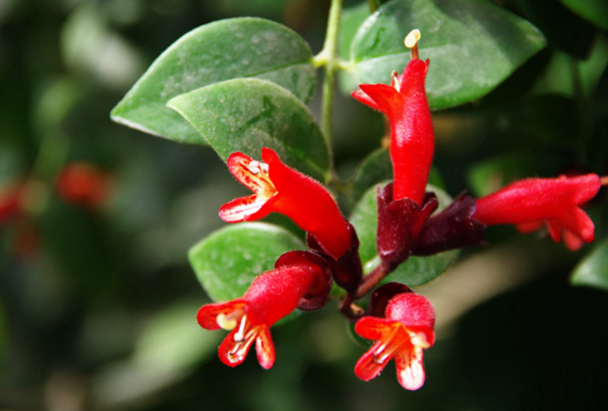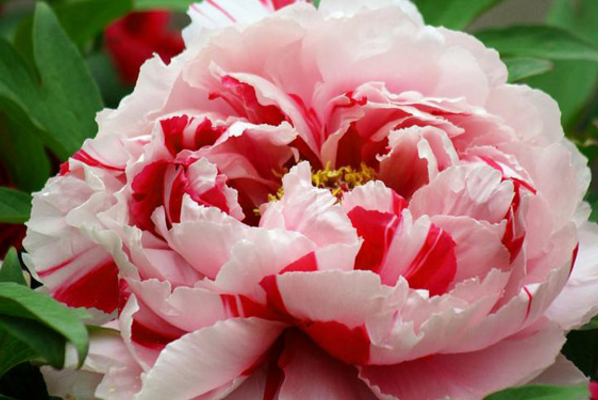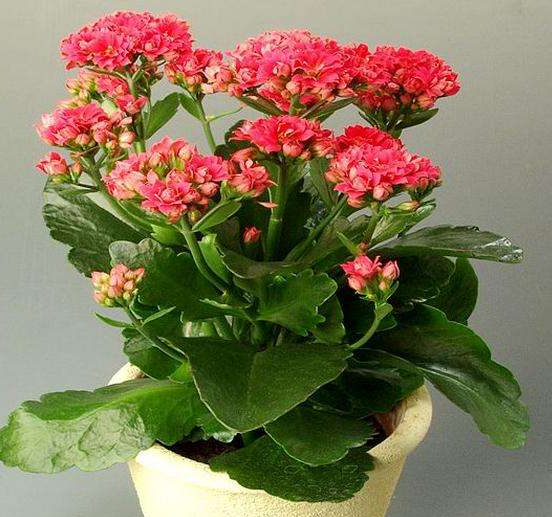Culture methods and matters needing attention of Carmine when to blossom
Lipstick, also known as lipstick orchid, is the Gesneriaceae, Gesneriaceae, Gesneriaceae evergreen lianas, also known as vines, red awn borage moss. Lipstick orchid is an excellent hanging plant introduced into China in recent years, and its flowers and leaves have high ornamental value.

When does lipstick blossom?
The greatest ornamental value of lipstick lies in the bright flowers, but in the maintenance process because do not know how to maintain, accidentally will not see it bloom for a long time.
1. The florescence of saffron
Lipstick orchids usually bloom from November of that year to June of the following year, but in some places the flowers only last until February. The total flowering period is between November and June, and the environmental differences, flowering and flowering time will be different in different places.
2. The reasons for the difference in flowering period of lipstick.
The difference of flowering time of saffron is mainly reflected in the climate difference between north and south. The difference of temperature, humidity and light will affect the flowering time of saffron. In addition, it is believed that the ability to change the environment is also very strong, potted lipstick is mostly in the balcony maintenance at home, the environment in each family is different, the natural time to bloom is also different.
3. What should be paid attention to during the flowering period of lipstick?
Saffron blossoms for a long time and blossoms in summer and autumn. it is necessary to ensure an adequate supply of fertilizer and water and apply sufficient mature organic fertilizer during cultivation. If the air is relatively dry, spray water on the leaf surface to increase the humidity of the leaf surface and the surrounding environment.
If there is a slight bud drop during flowering, it is a normal phenomenon, if there are more buds, there is a problem in maintenance. In general, plants are fertilized before flowering, but there is no need to apply fertilizer during the bud period. if heavy fertilizer is applied at the bud stage, it will lead to a large area of bud drop.
Culture methods and matters needing attention of saffron
1. Soil selection of saffron.
Saffron likes acidic soil, so it is best to choose slightly acidic pot soil for planting saffron, and peat soil, sand and vermiculite can be selected to prepare culture soil. An appropriate amount of calcium phosphate can be added to the soil. Or choose rotten leaf soil and coarse sand according to the proportion of 8:2, and then add a small amount of mature animal manure or compound fertilizer for cultivation.
2. How to water the lipstick
The growing period of Carthamus tinctorius is from March to September every year, and the temperature is higher during this period, and the water demand of the plant is larger, so it needs to be watered or sprayed frequently to increase the air humidity. Open windows as often as possible in summer. After autumn, the amount of water gradually decreased to improve the cold resistance of the plant.
3. Temperature requirements of saffron
The growth temperature of saffron is 18-30 ℃, and the optimum temperature is about 25 ℃. Its cold tolerance is relatively poor, and the overwintering temperature is above 12 ℃. It is necessary to keep the potted plants indoors in time in winter and avoid direct blowing by cold wind.
4. Illumination requirements of saffron.
Red orchids like to grow in a semi-overcast environment. In addition to the strong light at noon in midsummer, adequate light should be given at other times of the year. If the leaves of saffron turn red during maintenance, it is mainly because the room temperature is too low or the light is too strong, then you need to increase the room temperature in time. It is easy to cause if the temperature is too low for a long time. The phenomenon of leaves falling off and branches drying up.
5. Fertilization methods of saffron.
Saffron needs less fertilizer at ordinary times, and it is better to apply some rotten liquid fertilizer every two weeks.
When putting on the basin, add an appropriate amount of livestock hoof horns and broken bone pieces as base fertilizer to make it grow well. During the peak growth period of Carthamus tinctorius, mature organic fertilizer solution is applied once every 15-20 days, and after summer, more phosphorus and potassium fertilizers are applied, such as 0.1% solution of potassium dihydrogen phosphate and 20 times the solution of rotten fish visceral water and bone water.
6. matters needing attention in the culture of saffron.
Lipstick flowers on the pot to keep the soil moist, but should not be too wet, if caused by stagnant water, the roots are easy to rot or cause fallen leaves to often spray water mist on the leaves, keep the air humidity about 80%.
Hot summer, the need for shade, shade in about 50%. Or hang the saffron under the scaffolding of the balcony, shade with bamboo curtains, or hang the basin in the south-facing doors and windows where the light is sufficient.
Lipstick flowers avoid blowing branches so as not to break the drooping stems along the edge of the flowerpot. The weather is getting colder and colder in autumn, so the amount of water and fertilizer should be reduced gradually.
The culture method of lipstick when will it bloom?
Soil
Saffron likes acidic soil, so it is best to choose slightly acidic pot soil for planting saffron, and peat soil, sand and vermiculite can be selected to prepare culture soil. An appropriate amount of calcium phosphate can be added to the soil. Or choose rotten leaf soil and coarse sand according to the proportion of 8:2, and then add a small amount of mature animal manure or compound fertilizer for cultivation.
Watering
The period from March to September every year is the growing period of Carthamus tinctorius. During this period, the temperature is higher, the water demand of the plant is larger, and it needs to be watered or sprayed frequently to increase the humidity of the air. Open windows as often as possible in summer. After autumn, the amount of water gradually decreased to improve the cold resistance of the plant.
Temperature
The growth temperature of saffron is 18 to 30 ℃, and the optimum temperature is about 25 ℃. Its cold tolerance is relatively poor, and the overwintering temperature is above 12 ℃. It is necessary to keep the potted plants indoors in time in winter and avoid direct blowing of cold wind.
Light
Red orchids like to grow in a semi-overcast environment. In addition to the strong light at noon in midsummer, adequate light should be given at other times of the year. If the leaves of saffron turn red during maintenance, it is mainly because the room temperature is too low or the light is too strong, then you need to increase the room temperature in time. It is easy to cause if the temperature is too low for a long time. The phenomenon of leaves falling off and branches drying up.
Fertilizer application
Saffron needs less fertilizer at ordinary times, and it is better to apply some rotten liquid fertilizer every two weeks. When putting on the basin, add an appropriate amount of livestock hoof horns and broken bone pieces as base fertilizer to make it grow well. In the peak growth period of saffron, mature organic fertilizer solution is applied once in 15 to 20 days, and after summer, more phosphorus and potassium fertilizer is applied, such as 0.1% solution of potassium dihydrogen phosphate and 20 times the solution of rotten fish visceral water and bone water.
The culture method of lipstick when will it bloom?
Soil
Saffron likes acidic soil, so it is best to choose slightly acidic pot soil for planting saffron, and peat soil, sand and vermiculite can be selected to prepare culture soil. An appropriate amount of calcium phosphate can be added to the soil. Or choose rotten leaf soil and coarse sand according to the proportion of 8:2, and then add a small amount of mature animal manure or compound fertilizer for cultivation.
Watering
The period from March to September every year is the growing period of Carthamus tinctorius. During this period, the temperature is higher, the water demand of the plant is larger, and it needs to be watered or sprayed frequently to increase the humidity of the air. Open windows as often as possible in summer. After autumn, the amount of water gradually decreased to improve the cold resistance of the plant.
Temperature
The growth temperature of saffron is 18 to 30 ℃, and the optimum temperature is about 25 ℃. Its cold tolerance is relatively poor, and the overwintering temperature is above 12 ℃. It is necessary to keep the potted plants indoors in time in winter and avoid direct blowing of cold wind.
Light
Red orchids like to grow in a semi-overcast environment. In addition to the strong light at noon in midsummer, adequate light should be given at other times of the year. If the leaves of saffron turn red during maintenance, it is mainly because the room temperature is too low or the light is too strong, then you need to increase the room temperature in time. It is easy to cause if the temperature is too low for a long time. The phenomenon of leaves falling off and branches drying up.
Fertilizer application
Saffron needs less fertilizer at ordinary times, and it is better to apply some rotten liquid fertilizer every two weeks. When putting on the basin, add an appropriate amount of livestock hoof horns and broken bone pieces as base fertilizer to make it grow well. In the peak growth period of saffron, mature organic fertilizer solution is applied once in 15 to 20 days, and after summer, more phosphorus and potassium fertilizer is applied, such as 0.1% solution of potassium dihydrogen phosphate and 20 times the solution of rotten fish visceral water and bone water.
- Prev

Peony culture is not suitable for potted peonies how to water peonies
Peony flowers are elegant and magnificent. I believe everyone likes them very much. Like to raise one or two plants, in the breeding time careful care, I believe that in their own careful care, peonies will be able to raise bright colors. Peony culture is not suitable for peony flowering. Peony flowers are in full bloom.
- Next

Adopt the correct cutting method to blow up the pots of orchid and green apple in one month.
The biggest dream of a flower grower is that any flower can burst into a pot! If you look at it, you can only see the flowers but not the pots! However, not every kind of flower can easily burst the pot, but as long as you learn this kind of cutting method, the pot will burst in minutes ~ 1. Longevity flowers can be cut with leaves or branches.
Related
- Fuxing push coffee new agricultural production and marketing class: lack of small-scale processing plants
- Jujube rice field leisure farm deep ploughing Yilan for five years to create a space for organic food and play
- Nongyu Farm-A trial of organic papaya for brave women with advanced technology
- Four points for attention in the prevention and control of diseases and insect pests of edible fungi
- How to add nutrient solution to Edible Fungi
- Is there any good way to control edible fungus mites?
- Open Inoculation Technology of Edible Fungi
- Is there any clever way to use fertilizer for edible fungus in winter?
- What agents are used to kill the pathogens of edible fungi in the mushroom shed?
- Rapid drying of Edible Fungi

